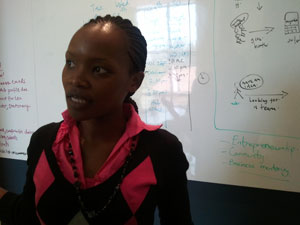Innovation hubs and co-working
For a long while I’ve been thinking about the value of physical place when it comes to people interacting around technology for entrepreneurial purposes.
Last week I visited the iHub, Nairobi’s famous innovation hub where local technologists, designers and researchers come together to work, for events, and hang out. While there, I had the pleasure of chatting with iHub research lead Jessica Colaco who explained a project they are working on regarding the different stages of hub evolution. Jessica calls Liberia’s iLab stage 1, the iHub stage 2, and a regional cluster or city-wide ecosystem like Hyderabad stage 3.

iHub researcher explains the innovation center evolution concept
In addition to these intentional examples, I’ve observed a growing number of community technology centers and libraries that are playing similar roles as the stage 1 example—though not be design. In the past year I’ve visited numerous public access venues in Bangladesh, Chile, Philippines, and Kenya. In each location I learned how many of these center’s heavy users are small business operators, independent BPO contractors, and other techie and non-techie entrepreneurs who are using these spaces as their offices. They are individuals, small groups who meet at pre-arranged times, and ad-hoc gatherings of people who come to a place because they know they’ll run into other folks with whom they can share ideas, get tips, and otherwise be in a space that fosters creativity and holds out the possibility of learning something new.
The community center examples are more appropriately characterized as co-working spaces, a concept Christine Prefontaine clued me into that sparked my interest in this. Read her posts for more about this movement. My feelings are best summed up by Clay Shirky, quoted in a NYT article about a co-working space in Brooklyn — “we systematically overestimate the value of access to information and underestimate the value of access to each other.”
Co-working spaces are close cousins of innovation hubs. What does this mean for libraries and telecenters? I agree with Christine when she says it can be a significant opportunity for such community centers. Others think so too. Seth Godin writing on libraries — “The next library is a place…where people come together to do co-working and coordinate and invent projects worth working on together.” In a chat with Richard Atuti, director of the Kenya National Library Service, he volunteered stories of this type of use with my only asking him what recent trends he’s observed in Kenyan libraries.
However, a physical place does not necessarily become a space where creative work and innovation occur. Design matters, along with services, rules and community. iHub founder Erik Hersman explains what makes the iHub work, and if the telecenter/library community wants to foster co-working and innovation at scale I believe it will need to be intentional about it, taking active steps to foster this type of use. They should learn from the proliferation of innovation labs, hubs, coalitions (like Afrilabs), and from research such as iHub’s own just launched 3-year study on the evolution of innovation spaces, and Georgia Tech’s Mike Best who is conducting a study in Ghana titled collaborative knowledge sharing as part of our Global Impact Study. Among other things, this study is undertaking formal experiments to assess how changes to the physical space and the introduction of sharing technologies affect the usage and outcomes of an Internet café’s visitors. Early findings are encouraging.
I think there is something important going on, and with focused attention there are huge opportunities to enhance the co-working, and innovation activities in community centers.
![]()


